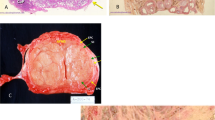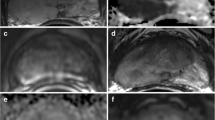Abstract
Purpose
Anatomic changes that coincide with aging including benign prostatic hyperplasia (BPH) and lower urinary tract symptoms (LUTS) negatively impact quality of life. Use of MRI with its exquisite soft tissue contrast, full field-of-view capabilities, and lack of radiation is uniquely suited for quantifying specific lower urinary tract features and providing comprehensive measurements such as total bladder wall volume (BWV), bladder wall thickness (BWT), and prostate volume (PV). We present a technique for generating 3D anatomical renderings from MRI to perform quantitative analysis of lower urinary tract anatomy.
Methods
T2-weighted fast-spin echo MRI of the pelvis in 117 subjects (59F;58 M) aged 30–69 (49.5 ± 11.3) without known lower urinary tract symptoms was retrospectively segmented using Materialise software. Virtual 3D models were used to measure BWV, BWT, and PV.
Results
BWV increased significantly between the 30–39 and 60–69 year age group in women (p = 0.01), but not men (p = 0.32). BWV was higher in men than women aged 30–39 and 40–49 (p = 0.02, 0.05, respectively) ,but not 50–59 or 60–69 (p = 0.18, 0.16, respectively). BWT was thicker in men than women across all age groups. Regional differences in BWT were observed both between men and women and between opposing bladder wall halves (anterior/posterior, dome/base, left/right) within each sex in the 50–59 and 60–69 year groups. PV increased from the 30–39 to 60–69 year groups (p = 0.05). BWT was higher in subjects with enlarged prostates (> 40cm3) (p = 0.05).
Conclusion
Virtual 3D MRI models of the lower urinary tract reliably quantify sex-specific and age-associated changes of the bladder wall and prostate.




Similar content being viewed by others
References
V. Mirone, C. Imbimbo, N. Longo, and F. Fusco (2007) “The detrusor muscle: an innocent victim of bladder outlet obstruction,” Eur. Urol., 51(1):57–66.
S. Deirmentzoglou, K. Giannitsas, P. Perimenis, T. Petsas, and A. Athanasopoulos (2012) “Correlation of ultrasound-estimated bladder weight to urodynamic diagnoses in women with lower urinary tract symptoms,” Urology. 80(1):66–70.
Ö. Güzel et al., (2015) “Can bladder wall thickness measurement be used for detecting bladder outlet obstruction?,” Urology, 86(3):439–444.
J. T. Wei, E. Calhoun, and S. J. Jacobsen (2005) “Urologic diseases in America project: benign prostatic hyperplasia,” J. Urol., 173:1256–1261.
H. Lepor (2004) “Evaluating Men With Benign Prostatic Hyperplasia,” Rev Uro. 6:S8-S15.
G. Fananapazir, A. Kitich, R. Lamba, S. L. Stewart, and M. T. Corwin (2018) “Normal reference values for bladder wall thickness on CT in a healthy population,” Abdom. Radiol., 43(9):2442–2445.
G. Franco et al. (2010) “Ultrasound assessment of intravesical prostatic protrusion and detrusor wall thickness—new standards for noninvasive bladder outlet obstruction diagnosis?,” J. Urol., 183(6):2270–2274.
A. Ahmed and M. Bedewi (2016) “Can bladder and prostate sonomorphology be used for detecting bladder outlet obstruction in patients with symptomatic benign prostatic hyperplasia?,” Urology, 98:126–131.
O. W. Hakenberg, C. Linne, A. Manseck, and M. P. Wirth (2000) “Bladder wall thickness in normal adults and men with mild lower urinary tract symptoms and benign prostatic enlargement.,” Neurourol. Urodyn., 19(5):585–93.
E. Bright, R. Pearcy, and P. Abrams (2012) “Automatic evaluation of ultrasonography-estimated bladder weight and bladder wall thickness in community-dwelling men with presumably normal bladder function,” BJU Int., 109(7):1044–1049.
H. Lee et al. (2014) “Changes in bladder wall thickness and detrusor wall thickness after surgical treatment of benign prostatic enlargement in patients with lower urinary tract symptoms: a preliminary report.,” Korean J. Urol., 55(1):47–51.
M. Oelke, K. Hoè Fner Á Birgitt, W. Volker, G. Newald, and U. Jonas (2002) “Increase in detrusor wall thickness indicates bladder outlet obstruction (BOO) in men,” World J Urol, 19(6):443–452.
C. Manieri, S. S. C. Carter, G. Romano, A. Trucchi, M. Valenti, and A. Tubaro (1998) “The diagnosis of bladder outlet obstruction in men by ultrasound measurement of bladder wall thickness,” J. Urol., 159(3):761–765.
A. M. Williams et al. (1999) “Prostatic growth rate determined from MRI data: age‐related longitudinal changes,” J. Androl., 20(4):474–480.
H.-C. Kuo, (2009) “Measurement of detrusor wall thickness in women with overactive bladder by transvaginal and transabdominal sonography,” Int. Urogynecol. J., 20(11):1293–1299.
O. Üçer, B. Gümüş, A. Can Albaz, and G. Pekindil (2016) “Assessment of bladder wall thickness in women with overactive bladder,” Urol, 42(2):97–100.
Y. Z. Ategçi, Ö. Aydoldu, A. Karaköse, M. Pekedis, Ö. Karal, and U. Fentürk (2014) “Does urinary bladder shape affect urinary flow rate in men with lower urinary tract symptoms?,” Sci. World J. 846856
X. Zhang et al. (2015) “Quantitative Analysis of Bladder Wall Thickness for Magnetic Resonance Cystoscopy,” IEEE Trans. Biomed. Eng. 62(10):2402-9.
A. Abou-Gamrah et al. (2014) “Ultrasound assessment of bladder wall thickness as a screening test for detrusor instability,” Arch Gynecol Obs., 289:1023–1028.
K. L. J. Rademakers, Gommert, A. Van Koeveringe, and M. Oelke (2017) “Ultrasound detrusor wall thickness measurement in combination with bladder capacity can safely detect detrusor underactivity in adult men,” World J Urol, 35:153–159.
F. Farag, M. Elbadry, M. Saber, A. A. Badawy, and J. Heesakkers (2017) “A novel algorithm for the non-invasive detection of bladder outlet obstruction in men with lower urinary tract symptoms Production and hosting by Elsevier,” Arab J. Urol. (Official J. Arab Assoc. Urol.) 15:153–158.
A. Bezinque, A. Moriarity, C. Farrell, H. Peabody, S. L. Noyes, and B. R. Lane (2018) “Determination of Prostate Volume: A Comparison of Contemporary Methods,” Acad. Radiol., 25(12):1582–1587.
B. Turkbey et al. (2013) “Fully Automated Prostate Segmentation on MRI: Comparison With Manual Segmentation Methods and Specimen Volumes,” AJR. 201(5):W720-9.
Z. Tian, L. Liu, Z. Zhang, J. Xue and B. Fei (2017) “A supervoxel-based segmentation method for prostate MR images” Med Phys, 44(2):558–569.
Author information
Authors and Affiliations
Corresponding author
Additional information
Publisher's Note
Springer Nature remains neutral with regard to jurisdictional claims in published maps and institutional affiliations.
Rights and permissions
About this article
Cite this article
Anzia, L.E., Johnson, C.J., Mao, L. et al. Comprehensive non-invasive analysis of lower urinary tract anatomy using MRI. Abdom Radiol 46, 1670–1676 (2021). https://doi.org/10.1007/s00261-020-02808-9
Received:
Revised:
Accepted:
Published:
Issue Date:
DOI: https://doi.org/10.1007/s00261-020-02808-9




